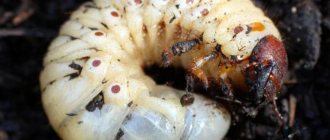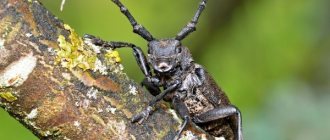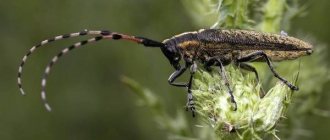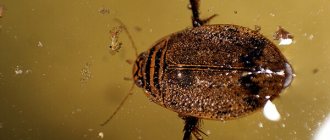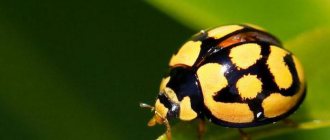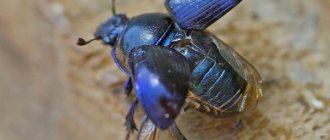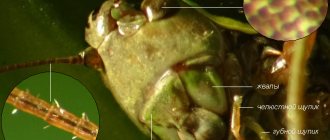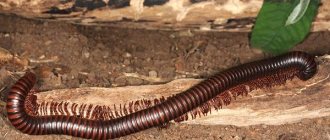Bronze beetle larvae and May beetle larvae, what is the difference? I didn't know. I think that many people do not know, but the cockchafer larva is an enemy, and the bronze beetle larva is a friend.
2012, potatoes were harvested, from 5 sq. m turned out to be 90 kg of potatoes . When harvesting potatoes, I collected a lot of fatty larvae, but examining each tuber, I did not find any damage to the potatoes. I've heard a lot that the larvae of the beetle (Chafer beetle) eat potato tubers. But they didn't touch my potatoes. I don’t use chemistry like “Prestige”, I don’t use any chemistry. Then why weren't they touching my potatoes?
I addressed this question to Alexander Viktorovich Timokhov by e-mail. ( MSU named after M.V. Lomonosov, Faculty of Biology, Department of Entomology, since December 1, 1995. Candidate of Biological Sciences since 1998).
I sent him photos of the larvae
Bronze beetle larvae
.
This is what A.V. Timokhov answered me: “Judging by what I see in the photo, these are larvae of the bronze beetle.
They have never been serious pests. More or less noticeable damage can be expected if only they occur in approximately the same quantities as in the first photo per 1 sq. meter. And even then......"
Taking my word for it, I didn’t think about it anymore. Moreover, you don’t often see the cockchafer here, but bronze beetles fly all summer.
This is a bronze, photo from the Internet.
This is a cockchafer. Photo from the Internet.
All my beds are mulched with fresh grass. Active mulch. Intensive beds.
If there is not enough grass, then I mulch with old leaves. Constantly, especially when harvesting potatoes, I found such larvae in large numbers, but they did not touch the potatoes. The entomologist was right!
I used to give all the larvae that I found to the birds.
Time has passed.
In the fall of 2014, my son and I put compost in boxes. (For what - it is written HERE ). My son noticed the very good quality of the compost. And, surprisingly, the best compost was where the larvae were swarming! It wasn't even compost anymore! Most of all, it looked like granular black soil! We selected the larvae by hand and gave them to the birds.
Another year has passed. In the fall of 2015, my son’s girlfriend helped me move the compost. This time, she noticed that where there are a lot of larvae, the compost is of excellent quality! And I remembered my son’s words last year….
That's it, young people notice everything when they want! And I? Sclerosis, you need to write it down...
We selected the larvae and poured them into a box with fresh compost (the box was filled in 2015). I don't know if they will survive there in the winter or not, but I hope they will. Starting in the spring, I will release bronze larvae there.
Conclusion:
Description and features of bronze
Metallic bronze is called because of its color. It is black, but the light is refracted, giving rainbow reflections. They are metal. Sometimes, in the photo, the bronze beetle looks like gasoline spilled in a puddle.
This reflection of light rays is due to the uneven, porous microstructure of the elytra and integument of the insect’s head. Its other features include:
- body length from 1 to 3 centimeters
- body width from 8 to 11 millimeters
- oval body shape
- rigid elytra that do not open in flight, which distinguishes the heroine of the article from the cockchafer
- the presence of side holes in the rigid elytra for extending transparent wings
Bronze beetles are very active beetles
Since the bronze beetle does not need to open or raise its elytra before flying, the beetle instantly rises into the air. It's easier for the insect there than for most of its relatives. Open elytra slow down flight. Bronzovkas move quickly and over long distances.
On the ground, or more precisely on plants, bronzes are slow and inactive. A beetle can sit on one flower for about 2 weeks. During precipitation, the insect slides down, burrowing into the ground.
Insects of the genus love warm, sunny weather. This is when beetles are most active. After sitting on roses, the bronze beetle can fly to another plant with the speed of a bumblebee. The flight is fast, but the insect is clumsy in it. Sometimes beetles do not have time to fly around people. After the collision, the bronze birds fall on their backs, turning over with difficulty and taking off again.
Types of bronze
There are 5 subspecies of Russian Bronzeworts. Each has several forms, differing in color. A defining feature is also the presence or absence of fluff on the body. In general, there are about 20 items. There are approximately 4 thousand species of bronzebacks on the planet. Most of them are tropical residents.
Bronzovkas of the temperate climate zone include:
1. Smooth. It reaches 3 centimeters in length, looks green, sometimes with blue and red reflections. The beetle is found near old trees, choosing large trunks.
The smooth bronze beetle can be easily distinguished from other beetles by the metallic sheen of its shell.
2. Smelly. This is no longer a green bronze beetle , but a black one with white markings. Representatives of the species live in the southern regions of Russia and neighboring countries. The body length of the bronze does not exceed 1.3 centimeters. The body of young individuals is covered with white hairs and has a strong smell.
Stinking bronze beetle
3. Marble. The length of the insect is 2.7 centimeters. The name of the species is associated with the black-bronze color, which is decorated with uneven, whitish lines. They resemble veins on black marble.
The photo shows a marble bronze
4. Golden bronze beetle . From the name it is clear that the elytra of the insect shine with yellow metal. The length of the beetle does not exceed 2.3 centimeters. Representatives of the golden species prefer to settle in gardens and vegetable gardens, choosing regions with black soil.
The golden bronze is distinguished by the golden sheen of its shell
Bronze beetles and cockchafers are often found there at the same time . In the latter, unlike the heroine of the article, not only do the elytra move apart, but the metallic reflection is not expressed.
Outside the country, in the tropics, there lives, for example, the Congolese bronze. It is colored black, yellow, orange-red. The beetle is large, lives in bushes and trees, feeding on their fruits, leaves, and flowers.
Tropical bronze species have a short life cycle. So, Congo beetles live only 2 months.
Congolese bronzes live in tropical forests
Beetle nutrition
What the bronze beetle eats depends on its species. Representatives of the smooth one love overripe fruits, so they do not damage the plantings. On the contrary, beetles act as a kind of orderlies, cleaning up already missing berries and fruits.
The Stinking Bronzewort eats pollen, which is basically harmless. So the beetles even contribute to pollination. However, stinky individuals also have a second favorite product - plant roots. These insects harm the plantings.
The marbled bronze settles in the forest-steppe zone, choosing plantings with an abundance of rotten trunks. Juice flows out of them, which the beetle feeds on. Therefore, the marbled appearance is harmless for agriculture.
The golden bronze likes to eat imported plants, so it is a malicious pest, destroying the crop, so to speak, on the vine.
The bronzer's diet also depends on its condition. Larvae, for example, eat only dead plants. They switch to living bronze beetles already in the beetle stage.
Iodine from cockchafer larvae. How to get rid of cockchafer larvae on strawberries
Methods of combating furrow weeds depend on their number and the preferences of the gardener. Strawberries can be treated with chemicals 30-60 days after picking the berries. To protect crops from pests, the following methods are used:
- mechanical - physical destruction of beetle larvae;
- chemical - the use of insecticides for soil treatment;
- folk - treating beds with infusions or growing plants nearby to repel pests.
Mechanical methods of protection
Plastic bottle for catching Khrushchev
The fight against cockchafer larvae on strawberries begins with the mechanical destruction of detected pests during planting and caring for the crop. When the first furrows are discovered, they dig up the earth along the bushes to a depth of 40-50 cm. If more than 4 pests are identified, it is necessary to take urgent control measures using folk or chemical methods.
It would be a good idea to collect adult beetles, because any of the females can lay eggs on the strawberry patch. In the early morning, insects are shaken off garden plants onto the canvas and destroyed. An effective way to catch cockchafers is to construct light traps:
- Trim the top of a 5-quart clear plastic container.
- Spread it inside with something sticky (grease, grease, etc.).
- Place a flashlight on the bottom.
- Leave overnight in the area where the beetles were spotted.
- In the morning, scald the trap with the caught insects with boiling water.
- If necessary, repeat the procedure.
An excellent preventive measure against pests is deep plowing (digging) of the site in autumn. The lower layers of earth with larvae rise to the surface when cultivating the earth. Birds eat furrows with pleasure; some of the parasites die under the influence of low air temperatures.
Insecticides to combat beetleworm
Chemical preparations for Khrushchev
If there is a large accumulation of furrows in the soil, it is necessary to immediately begin treating the soil with insecticides. Chemical preparations are good because the death of pests occurs within 24 hours. The fight against the cockchafer larva is carried out using one of the following means:
| Name (active substances) | Operating principle | Application |
| Karbofos solution (organophosphorus compound) | Paralyzes the digestive system. |
|
| Antichrusch (imidacloprid, bifenthrin) | Affects the insect's nervous system. |
|
| Biological product Nemabakt (nematodes infected with symbiotic bacteria) | Microorganisms settle in the body of the larvae and eat them from the inside. |
|
| Actara (thiamethoxam) | Contact-intestinal:
|
|
| Bazudin (Dazinon) |
|
Reproduction and lifespan
Bronzebirds of the temperate climate zone are active from late spring for a maximum of 4.5 months. However, the total life cycle is 2 years. They start from the egg stage. It is yellowish, deposited in compost heaps, anthills, and black soil.
Then the larva of the bronze beetle . They hatch from eggs after 2 weeks. The larvae are initially white, then molt twice and turn yellow, curling into a crescent shape. This occurs at a length of 6 cm.
Bronze larva
The beetle experiences the larval stage in its original shelter, for example, an anthill. Its inhabitants are indifferent to bronco babies, but badgers and foxes are not. Predators periodically tear apart anthills, feasting on beetle larvae.
The meal is possible until the first cold weather. Afterwards, the bronzes descend below the frost line. There the larvae pupate, secreting a sticky mass. Her bronzes are mixed with dust and earth.
The last stage is the beetle. It emerges from the pupa towards the end of spring. Now birds of prey pose a danger to the insect. The hairy bronze beetle and other representatives of the genus are a tasty morsel for rooks, jackdaws and rollers. Black-fronted shrikes, jays and orioles also hunt for beetles.
Bronzovka shaggy
Mole cricket egg laying
After the mating season and mating of two insects, the female begins to build a nest. The structure is a round cave with a diameter of approximately 10 cm. Such a cave is located in the soil, at a depth of about 15 cm it contains up to five thousand eggs.
To prevent molding, the female periodically turns over the clutch, inspects and makes a selection. Eggs are slightly oval balls, similar to grains. Their color is beige or brownish with a coating. From the outside, the mole cricket masonry resembles an ant masonry enlarged in size.
The insect does not make deep nests due to the fact that enough heat reaches them through the soil layer. Therefore, detecting masonry is not difficult; just walk around the area looking for characteristic hummocks. The larvae hatch in 14-21 days.
We can say that the larval form of the mole cricket is similar to long-bodied six-legged spiders or mutated crickets. The size of the larva is up to 15 mm. The structure of the front paws (they are turned outward) allows them to rake the earth in front of them.
In general, the larva differs little from the adult specimen, except in size. Active development includes five molts, after which the larva is considered sexually mature and capable of reproducing offspring.
The larval form does not develop in one season, so it overwinters in this form until next spring next to adult pests. The thickness of the fat layer will determine whether the insect will survive the winter cold. She doesn't really like the frost. Cold also affects future fertility.
The benefits and harms of bronze
What are the harm and benefits of a beetle? Bronzewort in its larval stage does no damage. On the contrary, voracious larvae loosen the soil and accelerate the processing of dead plants, helping to fertilize the soil.
is a different matter . how to fight it , since the insect eats flowers:
- roses
- peony
- phlox
- iris
- fruit and berry plants with light buds
Beetles sometimes eat flowers, along with peduncles and shoots. However, as was written earlier, only some types of bronzes are dangerous for gardens and vegetable gardens. They are fighting with them.
Bronzovka - a pest for roses
Lifestyle
Mole crickets are the oldest inhabitants of the planet; the fossil remains of some species that lived on the territory of modern Europe are about 30 million years old. These insects are extremely tenacious and easily adapt to any living conditions, so they are found everywhere.
Medvedka.
Today, the mole cricket family includes about 110 species, among which the most widespread is the common mole cricket, which is found in Eurasia and North Africa. The favorite habitats of mole crickets are fertile plains warmed by the sun, sandy soils and garden plots well fertilized with manure. These insects avoid deserted, dry places and try to stay in coastal areas in dry years.
Medvedka.
